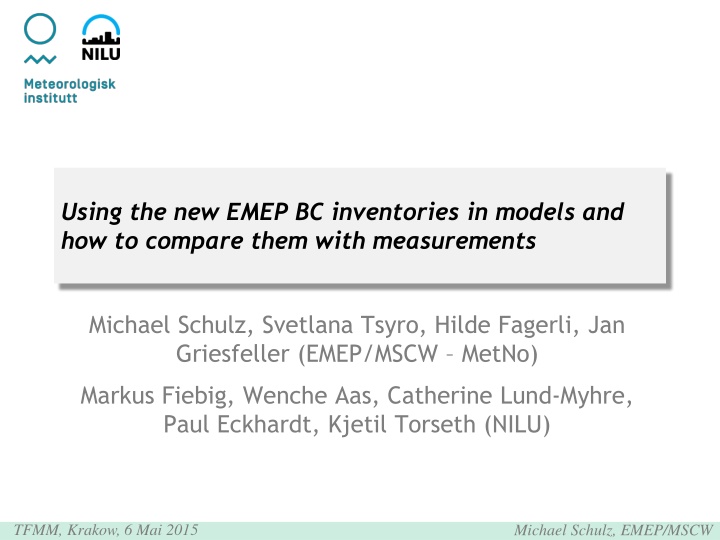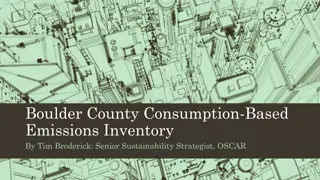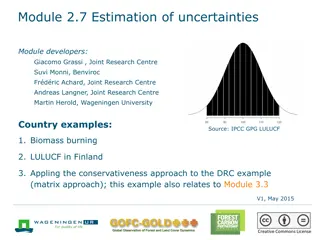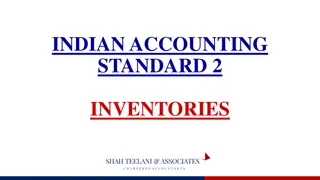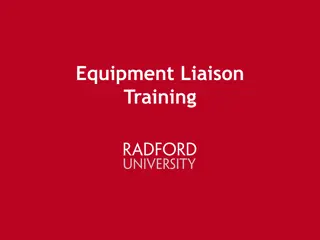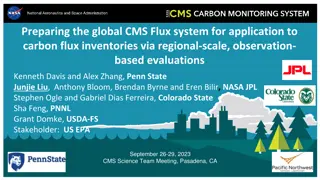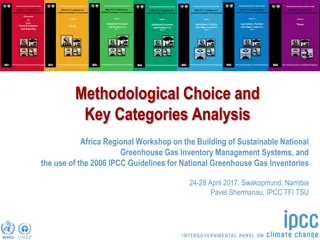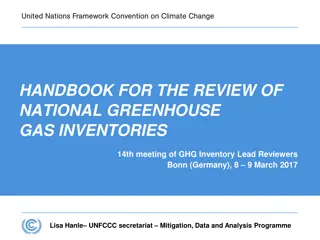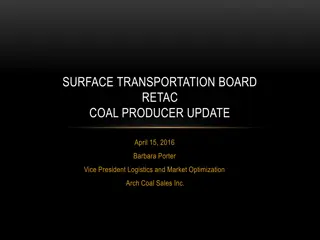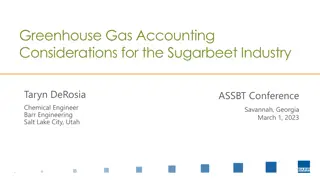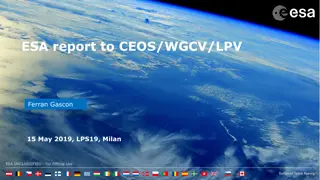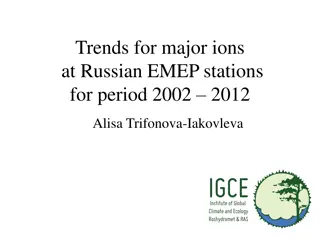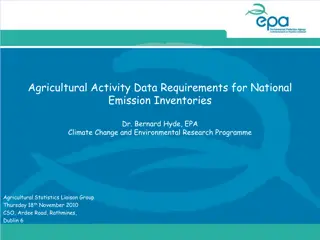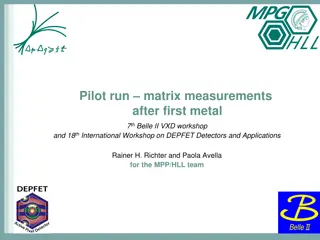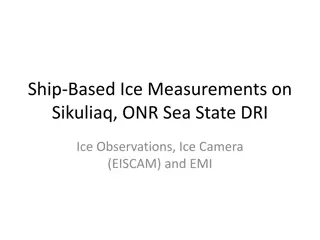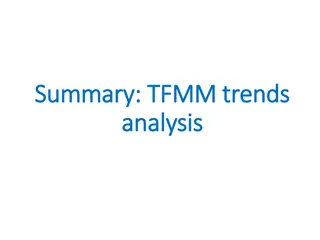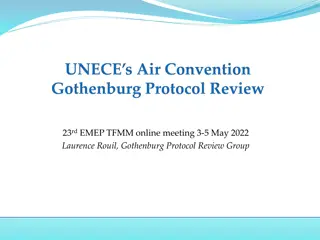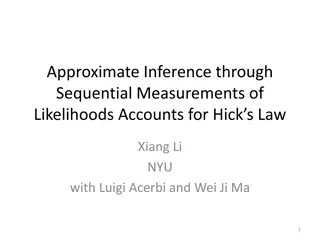Comparing New EMEP BC Inventories with Measurements
This presentation discusses the utilization of the new EMEP BC inventories in models and how they can be compared with measurements. It covers topics such as elemental carbon analysis, EU-ECLIPSE model results forced by anthropogenic emissions removal, the Gothenburg protocol revision of 2012 regarding BC emissions reporting, and the EMEP emissions of black carbon. The content emphasizes the importance of prioritizing emission reduction measures to benefit human health, the environment, and near-term climate change mitigation.
Download Presentation

Please find below an Image/Link to download the presentation.
The content on the website is provided AS IS for your information and personal use only. It may not be sold, licensed, or shared on other websites without obtaining consent from the author.If you encounter any issues during the download, it is possible that the publisher has removed the file from their server.
You are allowed to download the files provided on this website for personal or commercial use, subject to the condition that they are used lawfully. All files are the property of their respective owners.
The content on the website is provided AS IS for your information and personal use only. It may not be sold, licensed, or shared on other websites without obtaining consent from the author.
E N D
Presentation Transcript
Using the new EMEP BC inventories in models and how to compare them with measurements Michael Schulz, Svetlana Tsyro, Hilde Fagerli, Jan Griesfeller (EMEP/MSCW MetNo) Markus Fiebig, Wenche Aas, Catherine Lund-Myhre, Paul Eckhardt, Kjetil Torseth (NILU) TFMM, Krakow, 6 Mai 2015 Michael Schulz, EMEP/MSCW
Elemental Carbon (thermo-optical analysis) Acknowledgement ACTRIS PI s ? *Observations > Model*10 have been removed TFMM, Krakow, 6 Mai 2015 Michael Schulz, EMEP/MSCW
EU-ECLIPSE result GCM Model ensemble forced by removal of anthropogenic SO2 50 year average temperature response JJA DJF MAM SON Baker, L. H., Collins, W. J., Olivi , D. J. L., Cherian, R., Hodnebrog, ., Myhre, G., Quaas, J., and Samset, B. H.: Climate responses to anthropogenic emissions of short-lived climate pollutants, Atmos. Chem. Phys. Discuss., 15, 3823- 3862, doi:10.5194/acpd-15-3823-2015, 2015 TFMM, Krakow, 6 Mai 2015 Michael Schulz, EMEP/MSCW
EU-ECLIPSE result GCM Model ensemble forced by removal of anthropogenic BC 50 year average temperature response JJA DJF MAM SON Baker, L. H., Collins, W. J., Olivi , D. J. L., Cherian, R., Hodnebrog, ., Myhre, G., Quaas, J., and Samset, B. H.: Climate responses to anthropogenic emissions of short-lived climate pollutants, Atmos. Chem. Phys. Discuss., 15, 3823- 3862, doi:10.5194/acpd-15-3823-2015, 2015 TFMM, Krakow, 6 Mai 2015 Michael Schulz, EMEP/MSCW
Gothenborg protocol revision 2012 Parties should report BC emissions 2. A further objective is that Parties should, in implementing measures to achieve their national targets for particulate matter, give priority, to the extent they consider appropriate, to emission reduction measures which also significantly reduce black carbon in order to provide benefits for human health and the environment and to help mitigation of near- term climate change. Guidelines for Reporting Emissions and Projections Data under the Convention on Long-range Transboundary Air Pollution; Dec 2014 8. Substances for which emission reporting is encouraged include: (a) Black carbon (BC), which means carbonaceous particulate matter that absorbs light; TFMM, Krakow, 6 Mai 2015 Michael Schulz, EMEP/MSCW
EMEP Emissions of Black Carbon BC = PM fraction (OC/EC fraction from GAINS/IIASA for each country and sector) // Old trend run and new trend differ because PM emissions changed from EMEP to IIASA New BC inventory from countries Status reporting CEIP: 24 countries have reported sectoral emissions only one country with gridded emissions .normally transferred to MSCW in May .regridding problem BC+OM << PM Missing : (NotEstimated, NotRelevant) Germany, Poland, Russian Fed., Spain ..better to include before running EMEP model TFMM, Krakow, 6 Mai 2015 Michael Schulz, EMEP/MSCW
BC Emissions preview from CEIP database National totals Gg / year 1990 1995 2000 2005 2010 2013 TFMM, Krakow, 6 Mai 2015 Michael Schulz, EMEP/MSCW
Modelling of Black Carbon in the EMEP model At emission split of PM to OC/EC/Rest as a function of SNAP sector At source => 20% hydrophylic and 80% hydrophobic => Hydrophobic ageing rate 2-30 hours (f(location) Derivation of measured properties Absorption Coefficient using mass absorption efficiencies 8.5 m2/g hydrophobic 11.5 m2/g hydrophylic BC Tsyro et al, JGR, 2007 ;; Simpson et al. ACP 2012 TFMM, Krakow, 6 Mai 2015 Michael Schulz, EMEP/MSCW
Surface BC concentrations from 2 EMEP trend runs EMEP reporting 2013 Trend run EMEP PM emissions EMEP reporting 2015 Trend run IIASA PM emissions TFMM, Krakow, 6 Mai 2015 Michael Schulz, EMEP/MSCW
Gothenborg protocol revision 2012 Parties should report BC concentrations Upon the request of and in accordance with the timescales decided by the Executive Body, EMEP and other subsidiary bodies shall provide the Executive Body with relevant information on: (a) Ambient concentrations and depositions of sulphur and nitrogen compounds, as well as, where available, ambient concentrations of particulate matter, including black carbon, volatile organic compounds and ozone; TFMM, Krakow, 6 Mai 2015 Michael Schulz, EMEP/MSCW
Measurements of black carbon Elemental carbon by thermo-optical analysis (Cavalli et al., AMT, 2010) Absorption coefficient at wavelength xxx nm (M ller et al., AMT, 2010) MAAP, PSAP Mass absorption efficiency MAE=ABSC/EC TFMM, Krakow, 6 Mai 2015 Michael Schulz, EMEP/MSCW
EMEP model versus observations via the AeroCom webinterface GOALS: Make diverse model data comparison available Document observations available/used from CCC EMEP interface to trends / reports / development Help with model improvement Compare to other models (HTAP, AeroCom) TFMM, Krakow, 6 Mai 2015 Michael Schulz, EMEP/MSCW
New features of AeroCom webinterface to EMEP results http://aerocom.met.no/cgi-bin/aerocom/surfobs_annualrs.pl?PROJECT=EMEP TFMM, Krakow, 6 Mai 2015 Michael Schulz, EMEP/MSCW
New features of AeroCom webinterface to EMEP results http://aerocom.met.no/cgi-bin/aerocom/surfobs_annualrs.pl?PROJECT=EMEP TFMM, Krakow, 6 Mai 2015 Michael Schulz, EMEP/MSCW
Location of measurement sites in 2008 Elemental Carbon Absorption coefficient TFMM, Krakow, 6 Mai 2015 Michael Schulz, EMEP/MSCW
Location of measurement sites in 2012 Elemental Carbon Absorption coefficient TFMM, Krakow, 6 Mai 2015 Michael Schulz, EMEP/MSCW
Examples of model evaluation : Melpitz 2008 Elemental Carbon Absorption coefficient IFT, PI: KE Yttri, Andre Sonntag TFMM, Krakow, 6 Mai 2015 Michael Schulz, EMEP/MSCW
Examples of model evaluation : Melpitz 2012 Elemental Carbon Absorption coefficient IFT, PI: Gerald Spindler, Sonntag Andre TFMM, Krakow, 6 Mai 2015 Michael Schulz, EMEP/MSCW
Examples of model evaluation : Montseny 2012 Elemental Carbon Absorption coefficient ICTJA, PI: M. Pandolfi, Noemi Perez TFMM, Krakow, 6 Mai 2015 Michael Schulz, EMEP/MSCW
Examples of model evaluation : Ispra 2012 Elemental Carbon Absorption coefficient JRC, PI: JP Putaud TFMM, Krakow, 6 Mai 2015 Michael Schulz, EMEP/MSCW
Examples of model evaluation Puy de Dme 2012 Elemental Carbon Absorption coefficient CNRS-LAMP, PI: L. Bouvier, JM Pichon TFMM, Krakow, 6 Mai 2015 Michael Schulz, EMEP/MSCW
Examples of model evaluation : Cabauw 2012 Elemental Carbon Absorption coefficient TNO, PI: R. Spoor, M. Moerman TFMM, Krakow, 6 Mai 2015 Michael Schulz, EMEP/MSCW
Examples of model evaluation : Birkenes 2012 Elemental Carbon Absorption coefficient NILU, PI: K.E. Yttri, M. Fiebig TFMM, Krakow, 6 Mai 2015 Michael Schulz, EMEP/MSCW
Examples of model evaluation : Zeppelin 2012 Elemental Carbon Absorption coefficient NCSR, IAER, PI: V Sterios, K Eleftheriadis, P. Tunved TFMM, Krakow, 6 Mai 2015 Michael Schulz, EMEP/MSCW
Surface BC concentration evaluation of 2 different EMEP trend runs EMEP reporting 2013 Trend run EMEP PM emissions EMEP reporting 2015 Trend run IIASA PM emissions TFMM, Krakow, 6 Mai 2015 Michael Schulz, EMEP/MSCW
Absorption coefficient EMEP reporting 2013 Trend run EMEP PM emissions EMEP reporting 2015 Trend run IIASA PM emissions TFMM, Krakow, 6 Mai 2015 Michael Schulz, EMEP/MSCW
Model evaluation initiative In-situ optical properties (AeroCom/GAW/ACTRIS/EMEP/NOAA) Goals: (I) Evaluation of climatologies and covariance of dry aerosol optical properties in the models and measurements, (II) Analysis of long-term aerosol optical property trends in models and observations Using among others EMEP/NOAA/ACTRIS data on absorption coefficient at different wavelengths, profile data for mountain sites Workup-strategy: Assemble multi-model data at supersites 2010 by summer 2015, prepare global reference dataset for in-situ optical properties autumn 2015 => publication Participation call to modellers and observation experts is out organisers: NOAA/MetNo/NILU ask for detailed info to <Betsy.Andrews@noaa.gov> <michael.schulz@met.no> TFMM, Krakow, 6 Mai 2015 Michael Schulz, EMEP/MSCW
Concluding remarks Measuring EC and absorption coefficient in parallel adds confidence in BC model evaluation. MAE uncertainty is also of great value for climate modeling. Location should be better co-located for absorption coefficient and elemental carbon measurements Link to source attribution tools should be improved: Wood burning, dust, fossil fuel, wildfire plumes Data quality publications are needed EMEP-data comparison is ready to use with new BC emission inventory ! TFMM, Krakow, 6 Mai 2015 Michael Schulz, EMEP/MSCW
